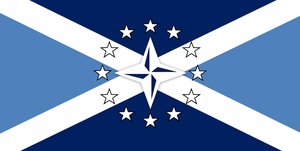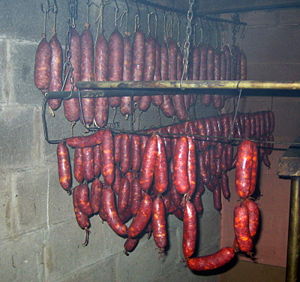Ventarya: Difference between revisions
mNo edit summary |
mNo edit summary |
||
| Line 29: | Line 29: | ||
| '''[[Federal Stanora|Stanora]] seats''' || 3 | | '''[[Federal Stanora|Stanora]] seats''' || 3 | ||
|- | |- | ||
| '''Official languages''' || [[ | | '''Official languages''' || [[Kalvertan Coscivian]] (primary)<br>[[Kiravic Coscivian]], [[High Coscivian]] | ||
|- | |- | ||
| '''Postal Abbreviation''' || VEN | | '''Postal Abbreviation''' || VEN | ||
| Line 93: | Line 93: | ||
===Languages=== | ===Languages=== | ||
The traditional and most widespread language of Ventarya is | The traditional and most widespread language of Ventarya is [[Kalvertan Coscivian]], which is also spoken in Hanoram and parts of Trinatria. Although the grammatical and lexical base of Kalvertan Coscivian is [stricken], it is overlaid heavily with Vexin Coscivian vocabulary and (in most dialects) an unmistakable Vexin phonology, with strong influences from Postclassical recensions of [[High Coscivian]], especially in literary forms. Linguists accept as many as eight (but more often six or seven) main dialects spoken in Ventarya. Kalvertan Coscivian has a history as a literary language, though it has always competed with High Coscivian in this respect, as well as more recently with Kiravic Coscivian. Kalvertan Coscivian is the native language of the majority of the rural population, as well as in Deneva (52%) and many smaller cities and towns. Outside of the Federal Capital Region and Telmar, most people have some command of Thínoran even if they are not native speakers. The regional language was aggressively suppressed under Kirosocialism, resulting in many urban and suburban residents educated during the Kirosocialist era having a weaker command of it than their children and grandchildren. | ||
[Fix tha aboon section to reflect lore rework ⇗ ] | |||
Kiravic Coscivian is the second most spoken language in the state, and is an important language in education and business. Second-languages speakers are common throughout the state, while native speakers are most heavily concentrated in the Kartika suburbs and Telmar, where it is the main language of daily life for most people, and the main ''lingua franca'' for interethnic communication, rather than Thínoran. Kiravic is a compulsory course of study in all secondary schools, and serves as the sole medium of instruction in just under half. Most school districts in majority non-Kiravic-speaking areas begin the transition to Kiravic in intermediate school. | Kiravic Coscivian is the second most spoken language in the state, and is an important language in education and business. Second-languages speakers are common throughout the state, while native speakers are most heavily concentrated in the Kartika suburbs and Telmar, where it is the main language of daily life for most people, and the main ''lingua franca'' for interethnic communication, rather than Thínoran. Kiravic is a compulsory course of study in all secondary schools, and serves as the sole medium of instruction in just under half. Most school districts in majority non-Kiravic-speaking areas begin the transition to Kiravic in intermediate school. | ||
Revision as of 13:41, 24 September 2021
| Grand Republic of Ventarya Lordakéarita Ventarya | |
 Flag | |
| Country | Kiravian Federacy |
| Capital | Méridatren |
| Largest city | Deneva |
| Population | 25,345,000 |
| Chief Executive | Íosevus Aldēmar (I) |
| Chancellor | Livyan Prātoverin (RP) |
| Stanora seats | 3 |
| Official languages | Kalvertan Coscivian (primary) Kiravic Coscivian, High Coscivian |
| Postal Abbreviation | VEN |
Ventarya is a state of the Kiravian Federacy, located on the southeastern coast of Great Kirav in the Míhanska Bay region. Ventarya was the second area of Great Kirav to be colonised by the Coscivian Empire and the first state admitted to the Confederate Republics of Kiravia.
Geography
Ventarya borders Míhanska Bay and the Aquaric Ocean to the east, Hanoram and the District of Coīnvra to the north, Trinatria to the south, and Transateranda to the west. The Míhanska coast is heavily indented with peninsulae and estuaries fed by the state's numerous rivers. Most of eastern Ventarya is part of the southeastern Aquaric Coastal Plain, with the terrain beginning to rise in the middle portion of the state into the foothills of the Aterandic Mountains.
Temperate mixed forests are the dominant form of vegetation in Ventarya, though many parts of the southwest belong more properly to the South Kiravian Conifer Forests ecoregion dominated by slash pine and longleaf pine. With the contraction of the agricultural sector in recent decades, extensive reforestation has occured in the coastal and central portions of the state that were cleared for cultivation following Coscivian settlement.
Countyships and Cities
Central Ventarya
Federal Capital Region
Shafton Roads Metroplex
Míhanska Baylands
- Méridatren (state capital)
History
Colonisation
Although Kiygrava was the first part of Great Kirav to be settled by Coscivians and Valēka was never rivalled as the island continent's economic core, the Míhanska Bay area (Ventarya and Hanoram) was the second part of the eastern seaboard where Coscivian colonies successfully took root. The first Coscivian settlements in what would become Ventarya were founded at X, Y, and Z by small companies of self-funded men, mostly drawn from among the gentry and minor nobility of Vrytha and northern Kórsa, most of whom belonged to Vexin Coscivian clans and brought Vexin cultural traditions to their new lands.
The colony developed a manorial economy based in large agricultural estates tended mostly by workers held in various forms of unfree labour relations, including indentured servitude and peonage, though over the course of Ventaryan history most unfree labourers were gradually converted into sharecroppers and copyholders.
The cultivation of these crops was a lucrative industry, and the Míhanska colonies quickly overtook Kiygrava in wealth and population. However, the decentralised and agrarian course of both colonies' development kept their populations largely dependent on Valēka and Old Coscivia for manufactures.
Republican Revolution
The Early Republic
As the most populous Kiravian state from XXXXX to XXXXX, Ventarya played a major political role in the Early Republic, often finding itself in rivalry with Kiygrava for preëminence in the infant federation.
Decline and Resurgence
Government
Ventarya is a presidential republic within the Kiravian Federacy. The bicameral state legislature comprises a lower House of Burgesses and an upper House of Trustees. The House of Trustees includes one Trustee representing each of the state's countyships and free cities, and one for each of several university constituencies.
The governor of Ventarya bears the title of Prime Executive, as do the governors of Hanoram and Cascada. The Prime Executive is serves a single, non-renewable five-year term, and former Prime Executives may run again only after being out of office for ten years.
Local government
Local government in Ventarya is characterised by stronger countyship governments and weaker municipal governments, which is reflective of the lesser degree and later onset of urbanisation in the state.
Society and Culture
Ventarya is culturally rich and has artistic and cultural traditions that strongly reflect traditional Coscivian ways of life in the region, as well as the post-Kirosocialist dynamics of cultural innovation and exchange. There is a rich and varied folk culture, home-grown in the villages and farmsteads which are often depicted as a symbol of the state. Highly cultivated Coscivian classical music and with its own distinct regional style is part of the cultural tradition of Ventarya, as well as a folk music repertoire of songs that depict day-to-day relationships, agrarian and waterside life, and the compelling natural beauty of the state.
The culture of the Vexin Coscivian clans to which many of the original settlers of the state belonged is pervasive, and the general culture of the state is built on largely Vexin foundations held in common with neighbouring Hanoram. Although most of the indentured and bonded labourers who came to form a majority of Ventarya's colonial population did not belong to Vexin clans, many did hail from Vexin-ruled areas of Old Coscivia. Owing to the cultural hegemony of the Vexin landowning élite, immigrants of non-Vexin origins typically adopted elements of Vexin culture and appropriated the trappings of the Vexin lower nobility when they or their descendants moved inland from the Baylands to become landowners in their own right. This gave rise to a Vexinate identity to the resulting Thínoran ethnic identity claimed by most of the state's established rural population, and has left a lasting legacy in the state's traditions, language, cuisine, political culture, educational system, and symbols.
Population Centres
Almost two-thirds of the Ventaryan population is concentrated in its three largest metropolitan areas. The largest of these, the Kartika Metropolitan Area, spills over from the District of Coïnvra into southern Hanoram and northern Ventarya. The Ventaryan portion of the metro area has undergone rapid economic and demographic growth over the past two decades as the governmental, defence, ærospace, and information technology sectors have boomed.
-Shafton Roads
Languages
The traditional and most widespread language of Ventarya is Kalvertan Coscivian, which is also spoken in Hanoram and parts of Trinatria. Although the grammatical and lexical base of Kalvertan Coscivian is [stricken], it is overlaid heavily with Vexin Coscivian vocabulary and (in most dialects) an unmistakable Vexin phonology, with strong influences from Postclassical recensions of High Coscivian, especially in literary forms. Linguists accept as many as eight (but more often six or seven) main dialects spoken in Ventarya. Kalvertan Coscivian has a history as a literary language, though it has always competed with High Coscivian in this respect, as well as more recently with Kiravic Coscivian. Kalvertan Coscivian is the native language of the majority of the rural population, as well as in Deneva (52%) and many smaller cities and towns. Outside of the Federal Capital Region and Telmar, most people have some command of Thínoran even if they are not native speakers. The regional language was aggressively suppressed under Kirosocialism, resulting in many urban and suburban residents educated during the Kirosocialist era having a weaker command of it than their children and grandchildren.
[Fix tha aboon section to reflect lore rework ⇗ ]
Kiravic Coscivian is the second most spoken language in the state, and is an important language in education and business. Second-languages speakers are common throughout the state, while native speakers are most heavily concentrated in the Kartika suburbs and Telmar, where it is the main language of daily life for most people, and the main lingua franca for interethnic communication, rather than Thínoran. Kiravic is a compulsory course of study in all secondary schools, and serves as the sole medium of instruction in just under half. Most school districts in majority non-Kiravic-speaking areas begin the transition to Kiravic in intermediate school.
Ethnosocial Groups
Ventarya was first settled by Coscivian colonists from the provinces of Vrytha (Thínorem and Taństem) and Kaltedan, as well as North Kórsa, and today the Thínorem, Southern Taństem, and Kaltem ethnosocial communities descended from these colonists remain the largest and most influential in the state. Most Thínorem have Vexin Coscivian clan affiliations or have assimilated into Vexin-derived Coscivian culture to a significant degree. There is significant overlap between these communal identities, though the degree of overlap is geographically uneven. The distinction between Taństan and Thínoran identity is strongest in the Baylands, where it carries class connotations differentiating the Taństan majority from the smaller Thínoran élite. Due to the strong Vexin cultural heritage of the state, many immigrants belonging to Vexin clans from various parts of Old Coscivia settled in Ventarya and Hanoram during the Great Crossing, a process that was repeated during the Third Wave of Coscivian migration to Kiravia when Vexin-descended groups in the wider Coscivian diaspora, such as Denev-Kaitotes and Peppergrass Islanders began arriving in the state.
Many Ventaryans have other ethnosocial identities and affinities. Many living along the mountainous western fringes of the state have an Eastern Highlander identity, and there have always been a large number of South Kiravians from neighbouring states, as well as communities of Antaric and Heronic Coscivians. The expansion of the Kartika metropolitan area into Northern Ventarya has caused the demographics of that region to resemble those of more northerly Eastern Seaboard suburbs, with many Kir Coscivians, Æran Coscivians, and Peninsular Coscivians. The Shafton Roads area around Telmar, due in large part to its industrial history and the presence of the Kiravian Navy, is the most ethnically diverse part of the state, and is home to the southernmost sizeable communities of Lúnstan Coscivians and Sea Coscivians in Great Kirav. A significant Melote population lives in the larger population centres.
The town of Konstanta in County Maddók is populated by people of Urcean descent who immigrated from [PROVINCE] in the Xth century.
Economy



Ventarya has transitioned from a historically agrarian economy to a modern and diversified one heavily invested in high-tech industry and services, transportation, and the defence industry. While the cultivation of kalir, tobacco, and various industrial crops and the raising of hogs remain important sectors of the state's economy and account for a large share of land use in the state, they directly employ far fewer Ventaryans today than in the past. As a legacy of the past, many corporations concerned with the processing and trade of products made from these crops remain headquartered in Central Ventarya and Shafton Roads.
Though located far from Kiravia's major high-tech corridors on the West Coast and the outer Valēka metropolitan area, a small but growing technology sector has taken root in Ventarya, drawing on human capital and investment generated by the state's prestigious research universities and by federally-supported engineering and research initiatives near Kartika and various military bases.
The defence industry and the Kiravian Forces are major contributors to the Ventaryan economy. Many large defence contractors are headquartered or have offices located in the Ventaryan portion of the Kartika Metropolitan area. Leading Kiravian weapons manufacturer Tredagon Arms Foundry is based in the town of Tredagon on the Barrima River and operates facilities in Shafton Roads. The Shafton Roads area is home to Shafton Naval Harbour, the Kiravian Navy's largest base and main centre of operations in Great Kirav, as well as several smaller dockyards and other installations. There are twelve military reservations in Ventarya, including Fort Bódran (operational headquarters of the Kiravian Army Marine Corps), and Fort Rilvitren (home to the Kiravian Army Rangers).
Construction is a key source of employment in Ventarya, driven by the demand for new development in and around the state's growing cities as rising land values demand denser development in the counties adjacent to Kartika and the suburban and exurban halos surrounding Kartika and Deneva push outward into the countryside.
Gallery
 |
 |
 |
 |
 |
 |
 |
 | |
 |